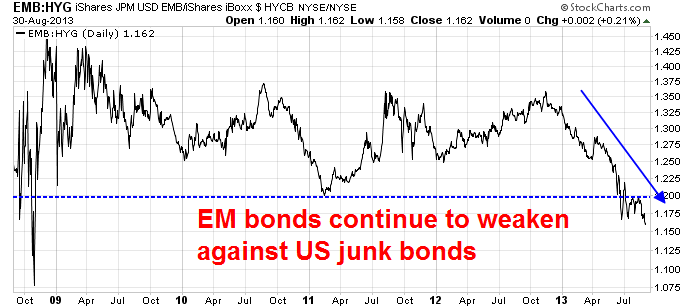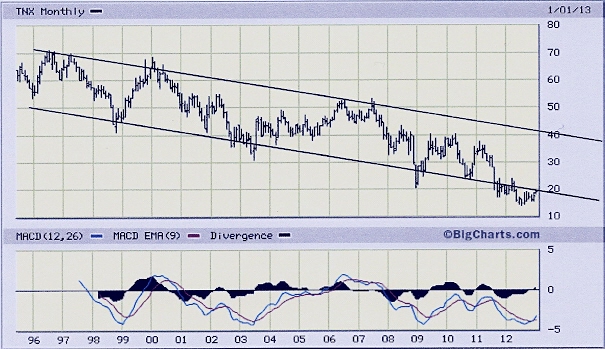Bonds & Interest Rates
 What I am concerned about is the re-emergence of tail-risk in the emerging markets. The Fed’s QE tapering has signaled that risk premiums are likely to rise (see my previous post Regime shift = Volatility). The Fed’s QE program was intended to push down Treasury, and later, MBS yields and to compress risk premiums in order to encourage market participants to take more risk and kick start economic growth. As the Fed signals that it is starting the process of unwinding this program, risk premiums are likely to rise.
What I am concerned about is the re-emergence of tail-risk in the emerging markets. The Fed’s QE tapering has signaled that risk premiums are likely to rise (see my previous post Regime shift = Volatility). The Fed’s QE program was intended to push down Treasury, and later, MBS yields and to compress risk premiums in order to encourage market participants to take more risk and kick start economic growth. As the Fed signals that it is starting the process of unwinding this program, risk premiums are likely to rise.
The news of the day from the Bank of Canada is that they will be holding the Bank Rate at 1%. The Bank also stressed the need to keep rates low for a while (the consensus of economists is that this will be the case until the 4th quarter of 2014) citing sluggishness in the Canadian economy and subdued inflation (core inflation that is, not the inflation that we experience in our everyday lives).
However, since Stephen Poloz ascended to Governor of the Bank of Canada in early June, longer-term market rates have actually increased despite his initial dovishness. In fact, on the 10-year Government of Canada Bonds the yield has risen from 2.05% to 2.70%. These longer-term bond yields affect the rates on most types of financing, including mortgages.
During the 30-Year Secular Bull Market in bonds, which ended in July 2012, central bank policy and the direction of longer-term bond rates in the market tended to move in unison. Bond investors placed a little more trust in the policymakers and were happy to take their cue and traded in the direction that central banks suggested they should. However, over the last year, things have changed. This has been especially the case with the U.S. Federal Reserve and the Bank of Canada.
So, although Poloz and the Bank of Canada have a desired target with respect to interest rates, we are witnessing that fact that the bond market needs to cooperate to make this happen. Without that, the dovishness in terms of Bank of Canada policy merely becomes rhetoric, the type of which good investors begin to tune out.
The opinions expressed in this report are the opinions of the author and readers should not assume they reflect the opinions or recommendations of Richardson GMP Limited or its affiliates. Assumptions, opinions and estimates constitute the author’s judgment as of the date of this material and are subject to change without notice. We do not warrant the completeness or accuracy of this material, and it should not be relied upon as such. Before acting on any recommendation, you should consider whether it is suitable for your particular circumstances and, if necessary, seek professional advice. Past performance is not indicative of future results.
Richardson GMP Limited, Member Canadian Investor Protection Fund.
Richardson is a trade-mark of James Richardson & Sons, Limited. GMP is a registered trade-mark of GMP Securities L.P. Both used under license by Richardson GMP Limited.
The Bank of Canada held its benchmark interest rate steady at 1 percent on Wednesday, as forecast, and said exports and business investment were taking longer than expected to replace household spending as the key driver of economic growth.
The U.S. Federal Reserve is widely expected to “Taper” it’s rate of purchasing mortgage bonds and Treasury bonds with newly printed money from a rate of $85 billion per month to about $70 billion. Some analysts argue that there are encouraging signs of economic growth in the U.S. and this reduced the need for massive liquidity injections.
However, those promising signs of economic growth are mostly the direct result of massive Quantitative Easing (QE). The recovery resembles “blowing into one’s own sails” and once QE slows, it is reasonable to expect that the economy will do so as well. The bottom line is that the amount of momentum built up by the QE experiment is suspect. There just is not much inertia. If there was, we would easily be able to see it.
Despite the lack of economic growth (and the fact that the so-called recovery is the most anemic on record following a recession), there is a surprising amount of consensus to begin “Tapering.” Some of the voting members at the Fed are concerned about the long-term adverse effects of QE, and so they should. However, I get the feeling that there is some urgency to prove that QE has worked. This is because Chairman Ben Bernanke’s term expires this upcoming January and it appears very likely that Obama will appoint someone else to the role. QE has been the centerpiece of Bernanke’s tenure. Instead of a policy that has worked well enough to allow him to scale it back, it has only grown in magnitude over the last five years as each earlier installment proves to be insufficient to meet his expectations. That said, it could be seen as an indictment against his leadership and foresight it he leaves after eight years with the money-printing spigots left wide open. If he can “Taper” in at the September meeting of the Federal Open Market Committee meeting and again before the end of the year, he might be able to point out that he is confident that it is time to scale back his policy experiment, declare victory, retire, and then hope for the best.
So, we can probably expect a “Taper” in a couple of weeks.
This is not the way a central bank should operate, but after a quarter of a century of dovish-leaning policies, maybe there is not much choice at this stage.
 This year is on track to be the worst for fixed-income investors since 1994, when the Federal Reserve surprised the market with rate increases. Money has flowed out of bond funds in 2013 at the fastest clip in nine years, with $57.3 billion leaving U.S.-listed taxable mutual funds and exchange-traded funds in the past three months alone, according to Lipper. U.S. Treasury yields have increased by more than a percentage point since May, a rise that has caught many analysts and investors off guard.
This year is on track to be the worst for fixed-income investors since 1994, when the Federal Reserve surprised the market with rate increases. Money has flowed out of bond funds in 2013 at the fastest clip in nine years, with $57.3 billion leaving U.S.-listed taxable mutual funds and exchange-traded funds in the past three months alone, according to Lipper. U.S. Treasury yields have increased by more than a percentage point since May, a rise that has caught many analysts and investors off guard.














